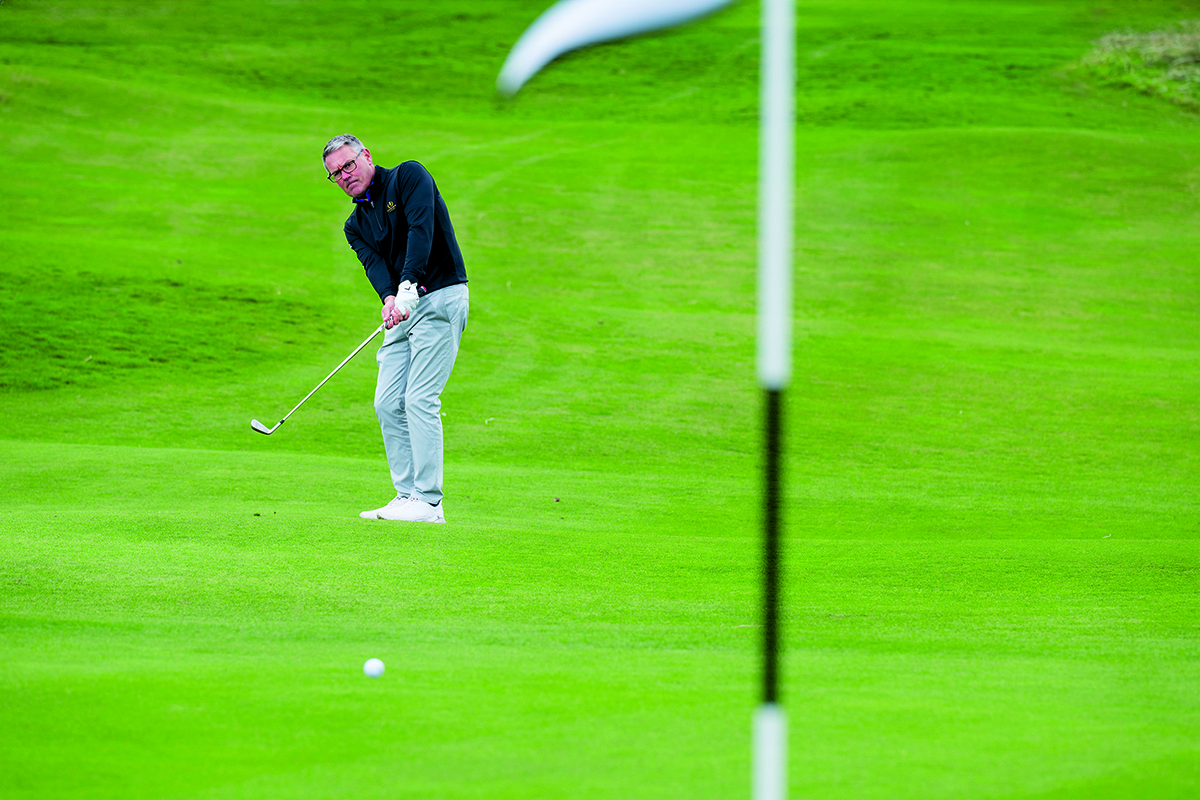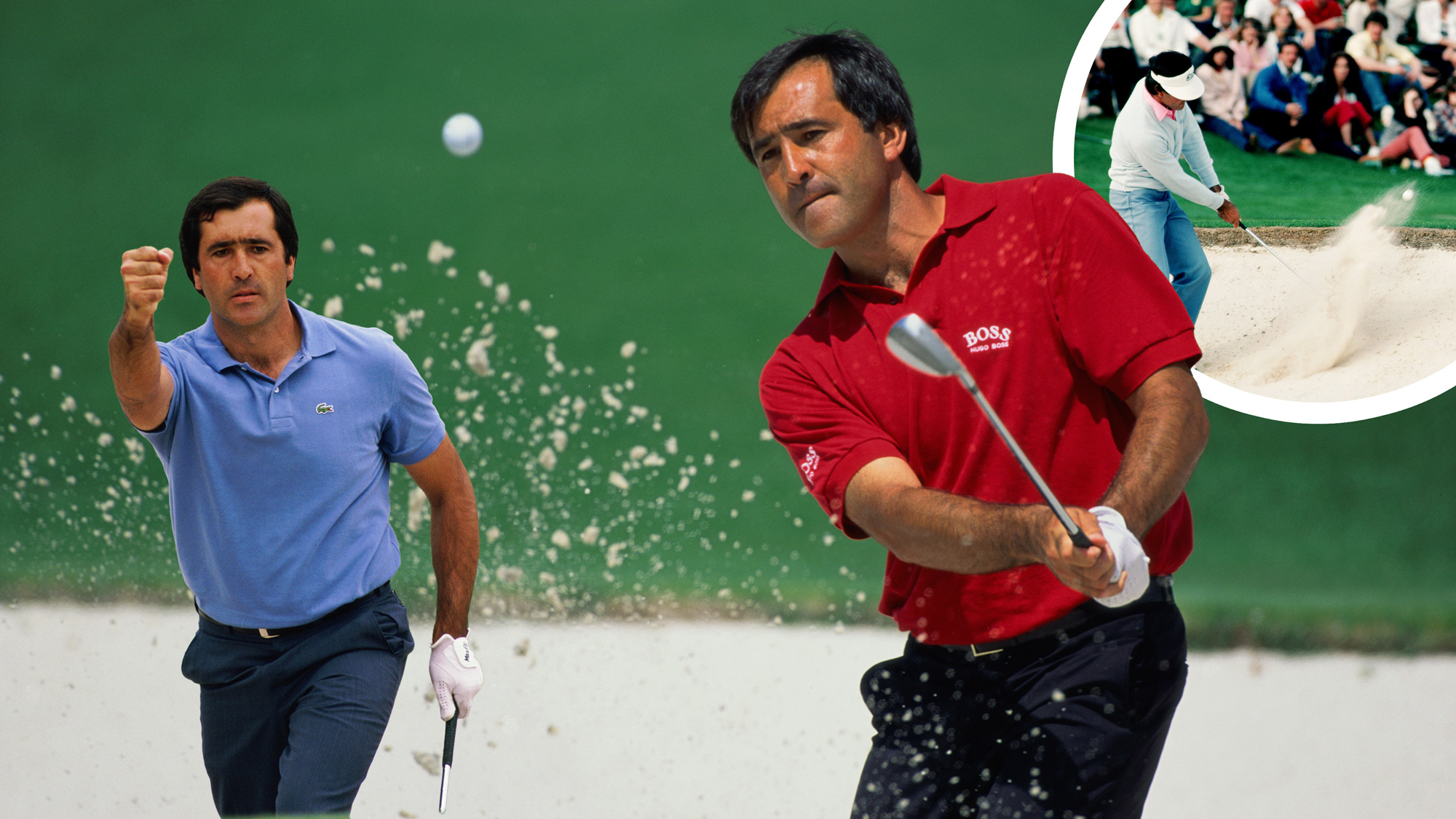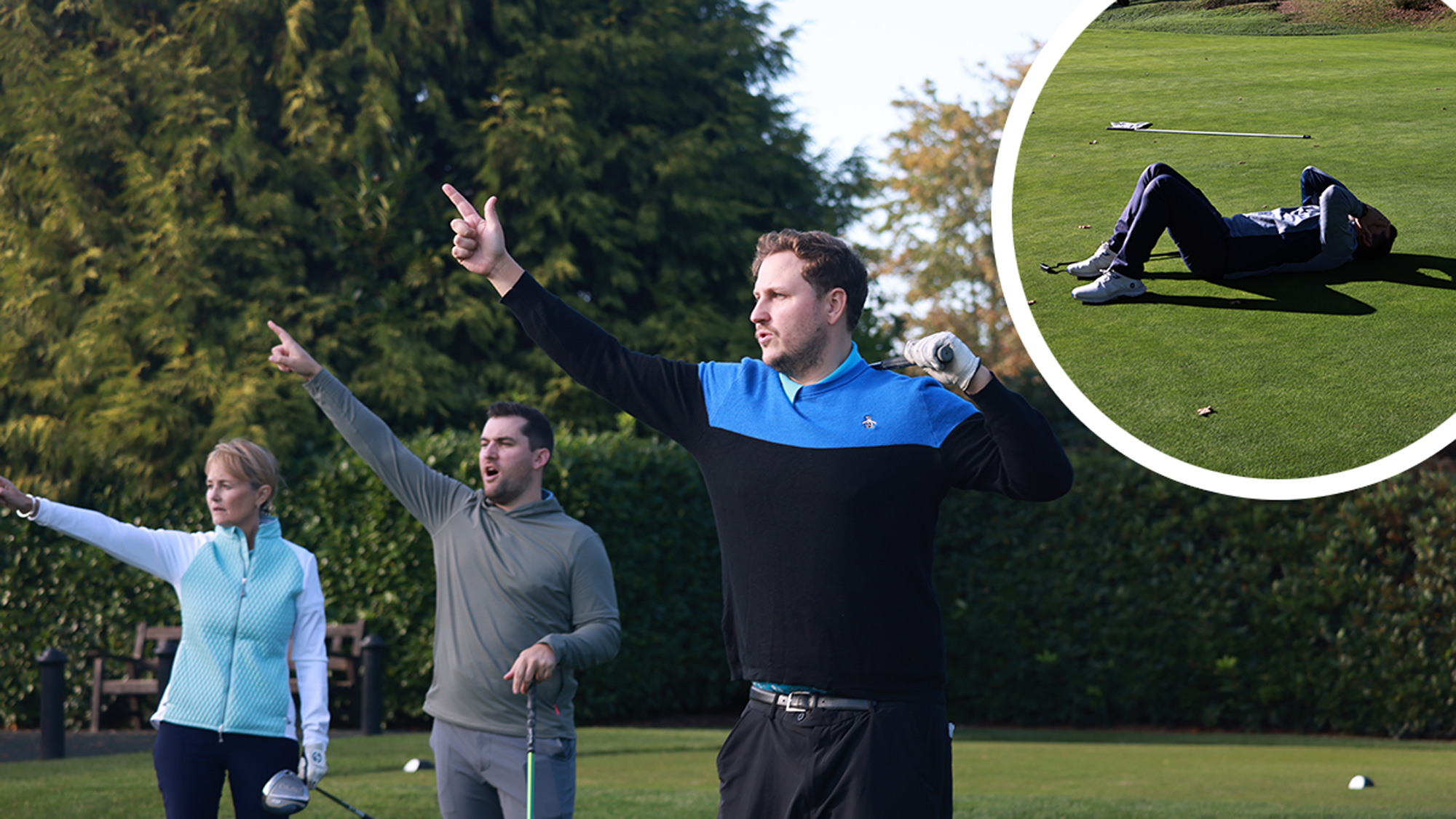I Attended An Exclusive Tee To Green Masterclass With A Top Golf Coach... Now I'm Sharing His 6 Transformative Tips With You
Few golfers get the chance to spend an entire day with a top golf coach, which is why I can't keep his six expert tips to myself. Get ready to play better golf!


Steve North
As an amateur golfer, I am always on the look out for ways that I can improve my game - so when the chance to attend a tee to green masterclass with one of the best coaches in the industry came along... I was quick off the mark to jump at the opportunity.
I spent plenty of time over the course of the last year working on my fundamentals, drilling the perfect golf grip, alignment and how far to stand from the golf ball, maintaining a straight left arm in the golf swing and understanding the correct ball position with every club.
After seeing some initial improvement, I was keen to put those key factors into play and take my game to the next level... and that's where Golf Monthly Top 50 Coach Steve North came in.
In this article, we share Steve's six transformative tips that I learned during his tee to green masterclass, in a bid to help you play your best golf this season...
Tee To Green Golf Masterclass: Steve North's Expert Tips

Steve spent almost two decades as the St. Andrews Links Golf Academy before embarking on a new venture as the Director of Academies for Golf Saudi in late 2024. Steve has worked with an incredible number of golfers, spanning the entire ability spectrum, helping each to improve their golf. His extensive experience and expertise are revered across the industry, with plenty of golfers crediting their improvement to his coaching.
When I give playing lessons, it always strikes me how quickly recreational golfers can show improvement with a few simple pointers and words of advice. Without getting hugely technical, various course strategy tips can go a long way to helping players shoot lower scores.
I was reminded of this recently when I played a few holes with my co-author here, Barry Plummer, a keen and relatively new golfer who has a lot of potential. I believe Barry learnt a lot from playing Turnberry on a cold, wintry day and, on the back of our playing lesson, I’m sure you can too.
Over the course of this article, I’ll be showing you how to tidy up your game from tee to green. If you’re just returning from a winter break, this is sure to help you quickly shake off that early-season rust.
Get the Golf Monthly Newsletter
Subscribe to the Golf Monthly newsletter to stay up to date with all the latest tour news, equipment news, reviews, head-to-heads and buyer’s guides from our team of experienced experts.
1. Tee Shots
Assess the task
Teeing the ball up before fully assessing the characteristics of the hole ahead is one of the most basic mistakes a golfer can make. Even if it’s a course you’re familiar with, be sure to look down the hole before you peg it up, as this can really help you to visualise the kind of shot you’re looking to play.
A post shared by Golf Monthly (@golfmonthly)
A photo posted by on
Use the whole tee box
A lot of club golfers are quick to tee the ball up in the centre of the tee box, instead of really using the whole area to their advantage. If you fade the ball, tee it up on the right side of the tee box and aim down the left side of the fairway; if you draw the ball, tee it up on the left side and aim down the right side of the fairway. This opens up the hole and gives you the best chance of finding the short stuff with your natural shot shape.

Using the tee box strategically will help you to play to your strengths and shot shape
2. Fairway Woods and Hybrids
Read the lie first
So, you’ve hit your driver well enough but you’ve landed in the rough. Forget distance and what club you need for a few moments. What you must do before anything else is assess the lie - it determines everything. Now, what’s realistic? Do you have the green light to go for the green? How will the lie affect the flight?
Adapt your setup to suit the lie
When the ball is sitting down in the rough as here, it’s going to come out with lower spin and won’t carry as far. The bunker up ahead could be in play, so a lay-up might be sensible. However, if you know you can carry it, you may still have a chance of reaching the green.
From this type of lie, the ball is going to land with quite a bit of release. I would move the ball position slightly further back in my stance, with a swing thought of creating a more descending blow, as I have to ‘get into’ the lie a little more than when it’s sitting cleanly.

Assess the lie first, then go about planning your next shot with that new information
3. Iron Play Tips
The Punch Shot
Being able to ‘punch’ your irons in windy conditions is a great asset to have, especially if you play a lot of links golf. If you’re playing into the wind, take an extra club, put the ball back in your stance, and get your weight and hands forward. You’re going to ‘squeeze’ the launch out low – that’s a good thought to have. By doing this, you’ll take spin off the ball to stop it climbing into the air and coming up short.

The setup is key when trying to play a punch shot under the wind on links golf courses
Different shots for different lies
You have to be able to adapt and hit different shots over the course of a round. Here, I’m facing a downhill lie over a bunker. In this situation, a lot of mid- to high-handicappers panic and lean back in an effort to get the ball in the air, which normally means the club bottoms out too soon, causing heavy shots.
Much like the punch shot, get the ball back in your stance, your weight forward onto the front foot and your hands forward, too. You need to ‘follow’ the slope. The ball is going to come out on a lower trajectory than on a regular shot, something you should also take into account.

Don't panic! Nail the setup, go through your process and commit to the shot
4. Chipping Tips
The ‘safety first’ bump-and-run
Sometimes you have no choice but to use lots of loft, but every golfer should learn how to play a bump-and-run – it’s really easy and can be such a reliable play. Position the ball more off your right instep, get your hands forward at set-up and feel as though your knees are ‘pinching’ forward a bit more. I’m going to get the ball running on the ground as soon as possible here using a 9-iron. There’s far less for me to think about – it’s all about practice and judging the amount of roll.

The bump-and-run shot is a crucial weapon to add to every golfer's arsenal
5. Bunker Play
Angle of attack
For a standard greenside bunker shot, I like to see the body slightly open to the target – that’s feet, hips and shoulders, with the weight sitting into your lead side. Get your hands forward and slightly lower than normal and position the ball opposite the lead heel.
These basics at set-up all help to promote the desired angle of attack.
I would also recommend turning out your lead foot a touch to encourage you to get through the ball. The more loft you have, the easier it will be to achieve a higher launch angle on the shot. More loft equals more bounce on the club, which will help it to slide underneath the ball.
Consistent point of entry into the sand
I always encourage golfers to practise entry point. I aim to hit a couple of inches behind the ball, and I don’t tend to vary that unless a specific shot requires it. Being consistent with your entry point means you’ll become better at controlling your distance. You can then vary the speed of your swing to propel the ball longer or shorter distances according to the demands of the shot.

A consistent entry point is valuable for bunker shots, but it needs practice to fully embed
6. Putting Tips
Judging the pace
I always think that it is harder to judge pace than line. However, this does become easier once you’ve learnt to set your ball off on the correct line. It’s then just about marrying the two together.
To get the feel of the pace required on those mid- to long-range putts that club golfers frequently face, I would recommend taking a few practice strokes without focusing down on the ball. Rather, look at the hole and just swing the putter back and through to get a real feel for the length of stroke required to get the ball close to the hole. Your eyes are a huge part of judging distance control through feel.
Start line is key
Club golfers often start the ball on the wrong line, as they don't understand how to effectively read putts. If you start a 40ft putt with four feet of left-to-right break low, it will get worse as it travels, ending up several feet from the hole.
Pace may have been spot on, but as your start line was off, it ends up looking pretty average. Using lines on the ball can help you to read the start line. Practise this as it’s important to be precise. Setting up a couple of tees and rolling the ball through a gate can also improve your strike and help to promote consistency.

Your eyes are a key tool for analysing a long putt, so be sure to look at the hole during your practice strokes
FAQs
Q: What does 'Strokes Gained: Tee to green' mean?
A: This is a measure, used in both amateur and professional golf, to measure a player's performance from the tee box to the green (and everything in between). It's the most all-encompassing metric in the game, measuring the overall quality of a player's performance across all areas of the game by comparing it against the rest of the field (or players of a similar ability across a data set).

Barry joined Golf Monthly in January 2024, and now leads the instruction section across all platforms including print and digital. Working closely with Golf Monthly's Top 50 Coaches, he aims to curate and share useful tips on every aspect of the game - helping amateurs of all abilities to play better golf. A member at Sand Moor Golf Club in Leeds, he looks forward to getting out on the course at least once a week in the pursuit of a respectable handicap.
Barry is currently playing:
Driver: Benross Delta XT Driver
Hybrid: TaylorMade Stealth 4 Hybrid
Irons: Benross Delta XT 5-PW
Wedges: TaylorMade RAC 60, Callaway Jaws MD5 54
Putter: TaylorMade Spider Tour
- Steve NorthTop 50 Coach
You must confirm your public display name before commenting
Please logout and then login again, you will then be prompted to enter your display name.
-
 14 Big Names Who Missed The Cut At The Masters
14 Big Names Who Missed The Cut At The MastersAn exciting prospect is in-store over the weekend at The Masters, where a number of players missed the cut at Augusta National
By Matt Cradock Published
-
 Why Rory McIlroy Is The Man To Beat At The Masters
Why Rory McIlroy Is The Man To Beat At The MastersWe look at three reasons why Rory McIlroy is in the driver's seat for the Green Jacket this weekend
By Elliott Heath Published
-
 Sandy Lyle Shared 3 Top Tips With Us Prior To Winning The Masters in 1988... And They Could Still Save You Shots 37 Years Later
Sandy Lyle Shared 3 Top Tips With Us Prior To Winning The Masters in 1988... And They Could Still Save You Shots 37 Years LaterThe 1988 Masters Champion shared his expert tips in the January 1988 issue of Golf Monthly, but they are still absolute gems for amateur golfers to this day...
By Barry Plummer Published
-
 Are You More Accurate Than The Average Amateur Golfer? Peter Finch Can Help You Hit More Fairways In 2025
Are You More Accurate Than The Average Amateur Golfer? Peter Finch Can Help You Hit More Fairways In 2025There is no better feeling than striping one down the middle of the fairway, but many amateurs struggle with accuracy. Peter Finch has four pro tips to help...
By Barry Plummer Published
-
 Are You A Victim Of This Destructive Golf Swing Fault? Let Me Help You Fix It Before You Tee It Up This Weekend
Are You A Victim Of This Destructive Golf Swing Fault? Let Me Help You Fix It Before You Tee It Up This WeekendAn overswing in golf is a destructive habit which can cost us precious shots on the golf course, but PGA Pro John Jacobs has a quick fix to get us game ready...
By Barry Plummer Published
-
 Do You Struggle With Distance Off The Tee? Try This Quick Fix To Make 2025 Your Biggest Golf Season Yet
Do You Struggle With Distance Off The Tee? Try This Quick Fix To Make 2025 Your Biggest Golf Season YetStruggling with distance off the tee could be a major reason why your handicap isn't coming down or your scores aren't improving, but our quick fix can help...
By Barry Plummer Published
-
 Seve's 'Lost' Bunker Lesson: Master Slopes And Transform Your Short Game Today
Seve's 'Lost' Bunker Lesson: Master Slopes And Transform Your Short Game TodaySeve's forgotten bunker lesson, from Golf Monthly's August 1983 issue, could hold the secret to better bunker play and supercharging your short game this season
By Barry Plummer Published
-
 Is Your Golf Swing Failing You? This All-Encompassing Drill Can Instantly Save It
Is Your Golf Swing Failing You? This All-Encompassing Drill Can Instantly Save ItAre you struggling with your golf swing? Discover the all-encompassing drill that can fix common swing faults and restore your game. Get back on track today!
By Tom Motley Published
-
 5 Things The Biggest Hitters Do To Generate Power In Their Golf Swing (And How You Can Copy Them)
5 Things The Biggest Hitters Do To Generate Power In Their Golf Swing (And How You Can Copy Them)Generating more power is a great way to improve your handicap and shoot lower scores. So, we analysed the biggest hitters in golf to help you hit it further...
By Barry Plummer Published
-
 Vijay Singh's Secret To Playing Better Golf Has Been In Our Archive Since 1992... And 33 Years Later It Could Still Radically Improve Your Swing
Vijay Singh's Secret To Playing Better Golf Has Been In Our Archive Since 1992... And 33 Years Later It Could Still Radically Improve Your SwingI scoured through the Golf Monthly archives to find expert golf swing tips from the best players in the world. This gem from Vijay Singh did not disappoint...
By Barry Plummer Published